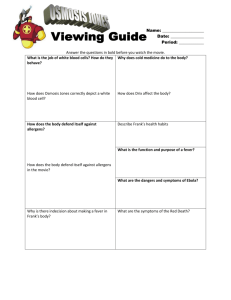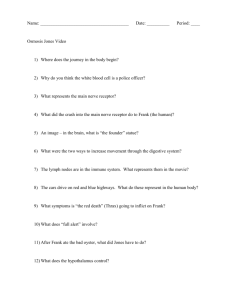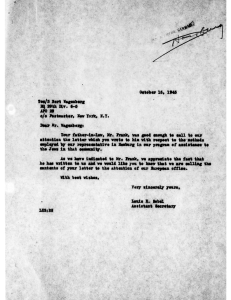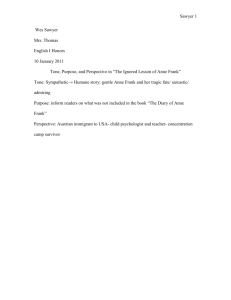File - Julie A. Saladin RN
advertisement
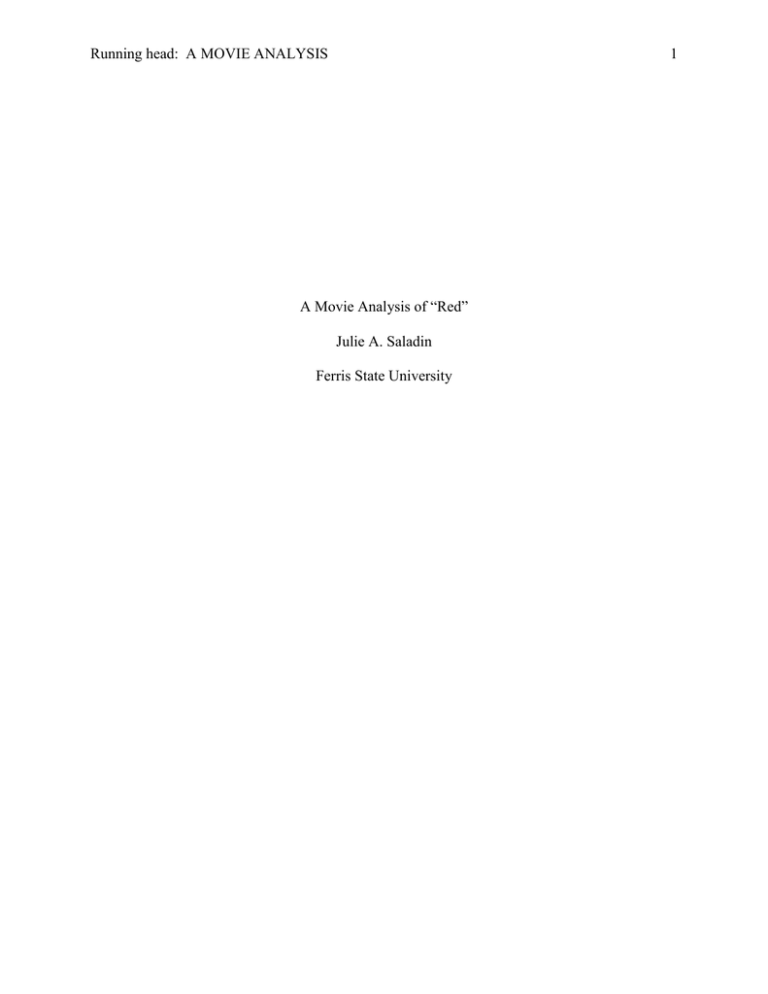
Running head: A MOVIE ANALYSIS 1 A Movie Analysis of “Red” Julie A. Saladin Ferris State University A MOVIE ANALYSIS 2 Abstract In this paper, this author describes basic concepts of sociological theories of aging and middle range nursing theory of health-related quality of life, and correlates them to characters identified in the motion picture “Red”. The concepts of sociological theories of aging are discussed within the role theory, activity theory, disengagement theory, continuity theory, age-stratification theory, and the modernization theory. Concepts explaining the middle range nursing theory of health-related quality of life include health and functioning, socioeconomics, psychological and spiritual, and family. Ageism, “the systematic stereotyping of, and discrimination against, people because they are old” (Touhy and Jett, 2012), is identified throughout the film and presented in this paper. A description of the motion picture’s content is provided to assist the reader in understanding the background of the characters and the basic plot of the film. A MOVIE ANALYSIS 3 A Movie Analysis of “Red” The purpose of this paper is to provide a summary of the motion picture “Red” and to help the reader understand the key characters. Understanding the characters is essential to relating them to the basic concepts found in sociological theories, and the health-related quality of life theories of aging. These theories attempt to explain changes in roles and relationships that accompany aging (Touhy & Jett, 2012) and the importance of improving and maintaining quality of life in promoting health. Correlating concepts of the theories with each character during different events in the film provides a better understanding of how these theories actually work. The concepts and how they relate to the characters will be explained and examples of ageism will be identified from multiple scenes in the film. Summary of Movie Di Bonaventura and Schwentke (2010) produce and direct the movie “Red” where Frank Moses , played by Bruce Willis, is a retired CIA spy who has settled into a mundane daily routine. His only contact with another person being telephone calls to Sarah Ross, played by Mary-Louise Parker, a pension office worker who Frank lies to about not receiving his pension checks, just so that he can speak to her. Sarah plays along, always stating that she will have another check sent out, and then the two discuss things like the book Sarah is currently reading, places she wants to visit, and her boring life. Eventually Frank builds up the courage to tell Sarah he will be in her area and would like to meet. Sarah not knowing if she wants to actually meet the man behind the phone calls, says to call her when he gets into town. Frank’s life quickly changes as a hit squad arrives at his house and his old training kicks in as he defends himself and realizes that his identity has been compromised. Frank also realizes that Sarah is probably in danger because of their telephone conversations, so after blowing up his A MOVIE ANALYSIS 4 home, he goes to Sarah’s home where she is not too excited about his letting himself in while she was out. Due to Sarah being apprehensive about Frank telling her that her life is in danger, he kidnaps her and eventually gains her trust as he reassembles his old CIA team. First, Frank finds Joe Matheson, played by Morgan Freeman, who is living in a nursing home with stage IV liver cancer. Joe reaches out to some old contacts to find out that it is the CIA that actually wants Frank and his team dead. Frank then finds Marvin Boggs, played by John Malkovich, who is paranoid and presents as a psychopath. Marvin eagerly joins forces with Frank. Eventually Frank, Sarah, Marvin, and Joe meet up with Victoria, played by Helen Mirren. Victoria removes a bullet from Franks arm and joins forces with the team. The team receives help from a Russian spy named Ivan Simanov, played by Brian Cox. Ivan and Victoria have a complex history as they were lovers before Victoria shot Ivan in the chest three times because she was ordered to do so by the CIA. Eventually, Frank and his team find that Alexander Dunning, played by Richard Dreyfuss, is responsible for ordering the teams death and the team shows that they still have what it takes to beat the odds in their older ages. This team showed that they were still the top notch agents that they were prior to retirement (Di Bonaventura & Schwentke, 2010). Sociological Theories of Aging The sociological theories of aging have several different concepts which attempt to explain how the process of aging is perceived. The theories discussed include the role theory, activity theory, disengagement theory, continuity theory, age-stratification theory, and the modernization theory (Touhy & Jett, 2012, pp. 37-38). Each theory defines a different concept. The role theory states that a person’s ability to adjust to new roles as he or she ages predicts whether or not he or she will adjust to the aging process (Touhy & Jett, 2012, p. 37). A MOVIE ANALYSIS 5 For example, the characters Frank Moses, Joe Matheson, Marvin Boggs, and Victoria were all trying to play the role of a retired person but all of them appeared to just be going through the motions. A person who retires, and is comfortably receiving a pension, should be able to enjoy life. Frank was living a boring and unhappy life with no interaction with the outside world. Marvin lived in fear of the real world and lived under ground. Victoria acted as though she loved retirement but said she took contracts on the side because “you can’t just flip a switch and become someone else” (Di Bonaventura & Schwentke, 2010). Joe lived in Green Springs Nursing Home with stage IV cancer and manipulated the nurses so that he could google their behinds. The characters did not exhibit signs of truly adjusting to their new roles as nonworking people. The activity theory basically states that in order to feel self-worth and satisfied with one’s life, a person must stay active (Touhy & Jett, 2012, p. 38). If a person does not remain active, the aging process most likely won’t be successful and health will be compromised. The team of retired CIA agents proved this to be true throughout the film because none of them truly felt alive until they were back to killing people and doing what they were doing as CIA operatives before they retired. The disengagement theory contends that it shows a natural sign of aging when an older person moves out of the way to allow for a younger person to take over his or her role (Touhy & Jett, 2012, p. 38). Di Bonaventura and Schwentke (2010) revealed this throughout the movie by presenting newer agents who were younger with William Cooper, played by Karl Urban, calling Frank Grandpa throughout the film. The records keeper named Henry, played by Ernest Borgnine, defended Frank’s age and honor by telling agent Cooper that Frank was the best agent the CIA every had. A MOVIE ANALYSIS 6 The continuity theory proposes that a person should continue with healthy habits and relationships that make them happy throughout the aging process (Education Portal, 2014). Di Bonaventura and Schwentke (2010) present the character Frank as being an unhappy older man with the same boring daily routine in the beginning of the film. Once he develops a relationship with Sarah and brings his team back together, his character changes into a vibrant and happy man who doesn’t seem old at all. This would show that continuity of relationships and doing the things that makes a person happy is important to the aging process and promoting health. The age-stratification theory is best explained by putting a person into a group with others similar to that person (Touhy & Jett, 2012, p. 38). An example of this is shown in the film when a female looks at Marvin and says “That’s right old man” (Di Bonaventura & Schwentke, 2010). The woman is putting Marvin into a group by calling him an old man and Marvin is clearly unhappy by her referring to him as old. The modernization theory claims that when a person is no longer able to continue to work and no longer needed because they have gotten too old and have been replaced, they no longer hold value (Touhy & Jett, 2012, p. 38). This is shown in the film when Agent Cooper refers to Frank as just a retired old man and is confused as to why anyone would bother with him to the records keeper Henry. Agent Cooper is basically stating that Frank has no value any longer and Henry defends Frank stating that he was the best the CIA ever had (Di Bonaventura & Schwentke, 2010). The sociological theories focus on a person as he or she changes roles and relationships throughout the aging process (Touhy & Jett, 2012). Roles and relationships are important factors in the aging process. In order to achieve positive relationships and appreciate a person’s roles as A MOVIE ANALYSIS 7 he or she ages, he or she must feel that the quality of his or her life is worth improving and maintaining. Health Related Quality of Life Theories of Aging The health-related quality of life (HRQoL) theory “focuses on the quality-of-life consequences of health status. Another related concept to HRQoL is well-being. Measures of well-being typically assess the positive aspects of a person’s life such as positive emotions and life satisfaction” (U.S. Department of Health and Human Services, 2010). Four areas of quality of life which impact an individual are health and functioning, socioeconomics, psychological and spiritual, and family (Peterson & Bredow, 2004). Di Bonaventura and Schwentke (2010), initially presented the elderly characters in the film as being dissatisfied with their lives as retired CIA agents. Frank lived in a nice house in the suburbs but lacked friends and social support. He went through the motions of fitting in without participating in social interactions with neighbors. The highlight of his day was his phone call to a complete stranger working in the pension office. Joe was an 80 year old man living in a nursing home with a terminal illness and who faked his own death when a hit man attempted to kill him. Marvin thought that everyone was out to get him and denied himself of any interaction with people. Victoria lived in a beautiful home where she arranged flowers and did some baking but often felt restless. Although these characters were portrayed as having mundane lives, their true personalities came to light when they were brought back together to defend those who were sent to kill Frank, Sarah, Marvin, and Joe. Joe came back to help his friends after faking his own death. He then willingly gave up his life to save the lives of Frank and Marvin because he knew he was dying of cancer and was at peace with that realization. Marvin had legitimate reasons for A MOVIE ANALYSIS 8 some of his paranoia and was perfectly satisfied using what others thought of as crazy to his advantage. Victoria was shot towards the end of the film and was content to give up her life but found happiness when her lost love Ivan saved her. Frank was finally felt alive and finally found love with a woman who loved him and accepted him for who he was. These friends had improved their quality of life because they found that they had the support of their CIA family and that they could still do what they loved doing (Di Bonaventura and Schwentke, 2010). Healthy People 2020 accentuates HRQoL and well-being with a goal of “promoting quality of life, healthy development, and health behaviors across all life stages” (2014). This goal was met in this film as evidenced by the characters satisfaction with their accomplishment and their plans to stay together and continue on to their next adventure. Their bond with one another and the fact that they were active again improved their quality of life, which positively affects health behaviors. Ageism Ageism is “the stereotyping of, and discrimination against, individuals or groups because of their age” (World Health Organization, 2014). The characters in the motion picture “Red” were subjected to ageism throughout the film. The young agent Cooper referred to Frank as Grandpa and grossly underestimated his abilities due to his being a retired elder. A man was sent to kill Joe as it was assumed it would be easy to take out an 80 year old man living in a nursing home. A woman referred to Marvin as an old man when she spoke to him simply because he appeared to be older because of features like grey hair and facial wrinkles. A CIA agent told agent Cooper that he just got his butt handed to him by a retiree after Frank beat him badly in a fist to fist fight (Di Bonaventura and Schwentke, 2010). These are examples of stereotyping retirees as old, fragile, and weaker than the young person. A MOVIE ANALYSIS 9 Participating in ageism is disrespectful to those that are being targeted. In the film, when the woman called Marvin an old man, Frank stated, “No respect” (Di Bonaventura and Schwentke, 2010). “Ageism serves as a social divider between young and old” (WHO, 2014). This motion picture depicted a definite delineation between young people and those that are retired. Those that were retired were portrayed as old and used up. The fact that these retired characters proved the younger generation wrong is what made this motion picture desirable. In conclusion, the motion picture “Red” depicted many examples of the concepts explained by the sociological theories and the HRQoL theory. It showed the importance of adapting to new roles and developing relationships. The characters in the film shared in an improved quality of life and well-being by coming together and performing activities that they had participated in while they were still working. They exhibited a renewed energy proving to those who participated in ageism that they were just as important and useful as the younger generation. The aging process is one that should be cherished and valued. This film, although not completely realistic, shows that the aging process does not mean giving up quality of life and total well-being. The aging process involves promoting an increased quality of life and wellbeing that will improve and maintain the health care continuum. A MOVIE ANALYSIS 10 References Di Bonaventura, L. (Producer), Schwentke, R. (Director). (2010). Red. United States: Deluxe Digital Studios Education Portal. (2014). Psychosocial theories of aging: Activity theory, continuity theory & disengagement theory. Retrieved from http://educationportal.com/academy/lesson/psychosocial-theories-of-aging-activity-theory-continuitytheory-disengagement-theory.html#lesson Healthy People 2020. (2014). Health-related quality of life and well-being. Retrieved from http://www.healthypeople.gov/2020/topicsobjectives2020/overview.aspx?topicId=19 Peterson, S.J. & Bredow, T.S. (2004). Middle range theories: Application to nursing research. Philadelphia: Lippincott Williams & Wilkins. Touhy, T. A., & Jett, K. F. (2012). Ebersole & Hess' toward healthy aging: Human needs & nursing response (8th ed.). St. Louis, Mo.: Elsevier/Mosby. U.S. Department of Health and Human Services, Healthy People 2020. (2010). Foundation health measure report: Health-related quality of life and well-being. Retrieved from http://www.healthypeople.gov/2020/about/HRQoLWBFullReport.pdf World Health Organization (WHO). (2014). Are you ready? What you need to know about ageing. Retrieved from http://www.who.int/world-healthday/2012/toolkit/background/en/index3.html
